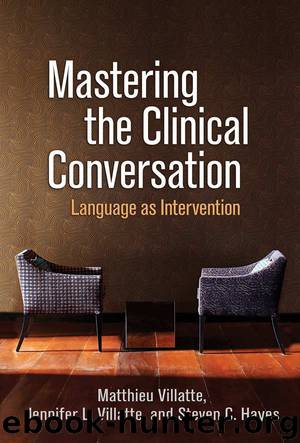Mastering the Clinical Conversation by Matthieu Villatte & Jennifer L. Villatte & Steven C. Hayes

Author:Matthieu Villatte & Jennifer L. Villatte & Steven C. Hayes [Villatte, Matthieu]
Language: eng
Format: epub
ISBN: 9781462523085
Publisher: Guilford Publications
Published: 2015-11-17T02:00:00+00:00
Finding Responsibility in the Interaction
The last component of building a flexible self is to develop a balanced sense of responsibility. Two typical opposite positions often lead clients to dead ends when considering their role in the relationship between causes and consequences. Often, they see themselves as excessively responsible for their actions and for the results of their actions; conversely, they may think that they have no control over their actions and that outcomes are independent of what they do. In the first case, we find clients who experience a lot of shame, who self-criticize, and who beat themselves up for not being able to change and obtain what they want. They spend a fair amount of time trying to change a self seen as the primary or even unique cause of their difficulties. In the second case, we find clients who feel hopeless, out of control, or insignificant and think that they can’t do anything to change their condition. They see their self at most as a mere outcome of external variables, which they can’t ever reach to make a difference in their lives.
Developing a balanced sense of responsibility consists instead of approaching the self as a situated action; that is, as an interaction between an organism and the contextual variables of its environment. In this view, the self is neither a primary cause nor a final consequence. Self is both a consequence and a set of actions that impact other actions; it is influenced by contextual variables and able to influence these variables in return. From a functional contextual perspective, the influence exerted by the self on contextual variables is itself influenced by contextual variables. However, just as all operant behaviors impact the environment and are produced by the environment, these forms of influence are not linear and unidirectional but are multidirectional.
This way of approaching the self has two advantages. On the one hand, it undermines the responsibility of the self when the client feels excessively responsible for what is happening to him. It helps him consider other variables, which may have a more decisive impact on his behaviors and on the production of more desirable outcomes. On the other hand, it increases the client’s willingness to change contextual variables that are behaviorally important, which helps the client engage in new actions, allowing desirable outcomes to occur.
Obviously, it would be a very rare day that any of these technical terms would be used with clients; we would not usually use terms such as self-concept or hierarchy either, and the reader will search in vain for technical terms of this kind in the previous vignettes. Developing an interactive sense of self occurs through natural verbal interactions, which, as with the other components of the flexible self, emphasize concrete observation. Given the bidirectional nature of the relationship between the organism and the contextual variables, the techniques you can use go in reversed directions. Some techniques consist of drawing the client’s attention to the influence of contextual variables, whereas other techniques improve awareness that the client’s actions can have an impact on these variables.
Download
This site does not store any files on its server. We only index and link to content provided by other sites. Please contact the content providers to delete copyright contents if any and email us, we'll remove relevant links or contents immediately.
Periodization Training for Sports by Tudor Bompa(8170)
Why We Sleep: Unlocking the Power of Sleep and Dreams by Matthew Walker(6618)
Paper Towns by Green John(5090)
The Immortal Life of Henrietta Lacks by Rebecca Skloot(4525)
The Sports Rules Book by Human Kinetics(4294)
Dynamic Alignment Through Imagery by Eric Franklin(4118)
ACSM's Complete Guide to Fitness & Health by ACSM(3989)
Kaplan MCAT Organic Chemistry Review: Created for MCAT 2015 (Kaplan Test Prep) by Kaplan(3940)
Introduction to Kinesiology by Shirl J. Hoffman(3726)
Livewired by David Eagleman(3684)
The Death of the Heart by Elizabeth Bowen(3552)
The River of Consciousness by Oliver Sacks(3541)
Alchemy and Alchemists by C. J. S. Thompson(3451)
Bad Pharma by Ben Goldacre(3357)
Descartes' Error by Antonio Damasio(3230)
The Emperor of All Maladies: A Biography of Cancer by Siddhartha Mukherjee(3066)
The Gene: An Intimate History by Siddhartha Mukherjee(3047)
The Fate of Rome: Climate, Disease, and the End of an Empire (The Princeton History of the Ancient World) by Kyle Harper(3003)
Kaplan MCAT Behavioral Sciences Review: Created for MCAT 2015 (Kaplan Test Prep) by Kaplan(2940)
